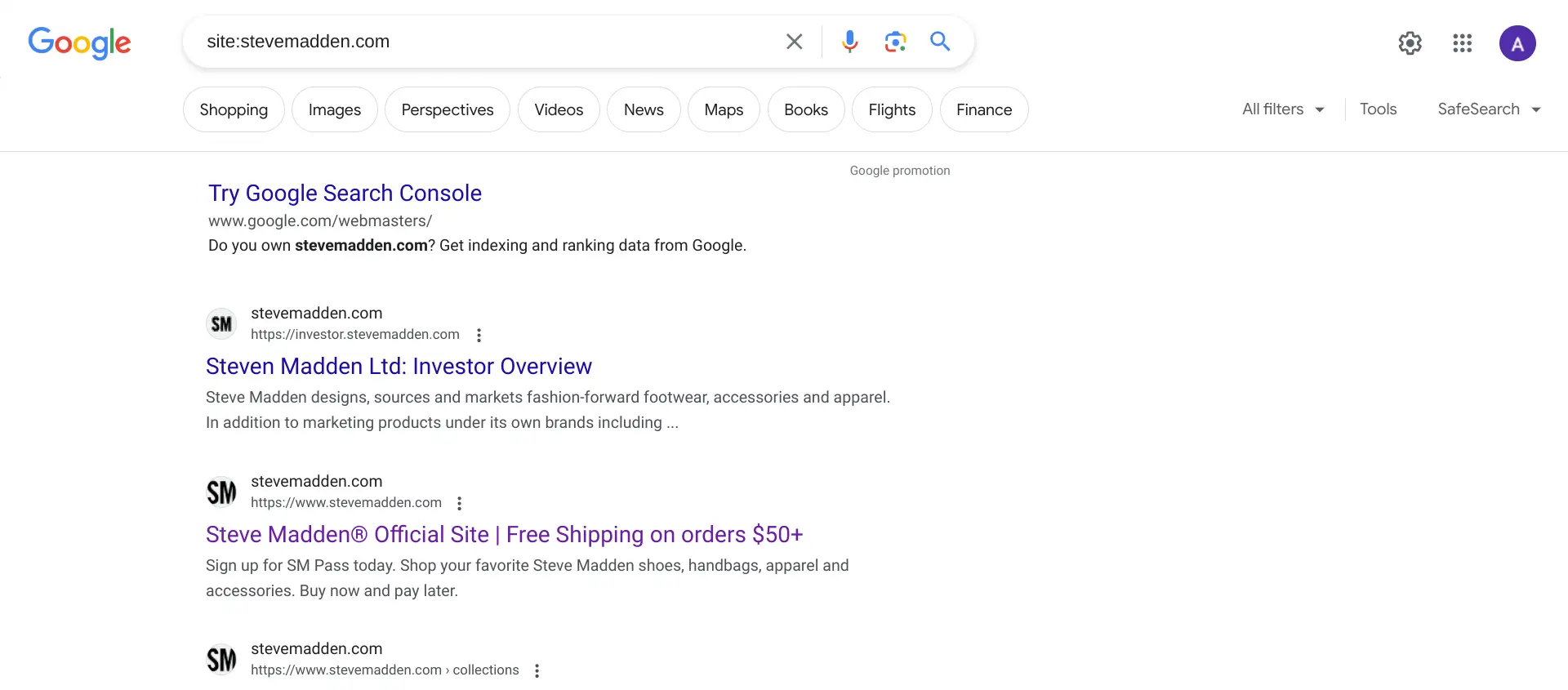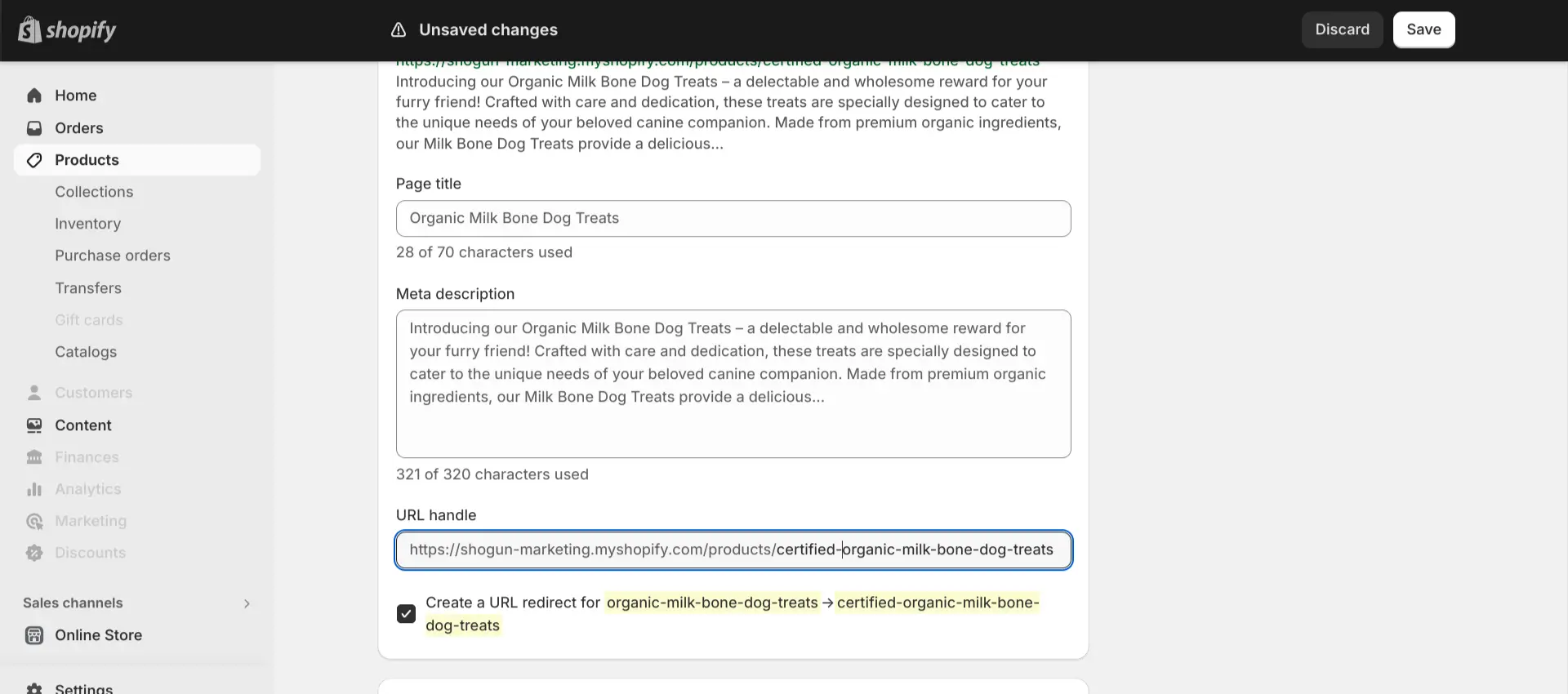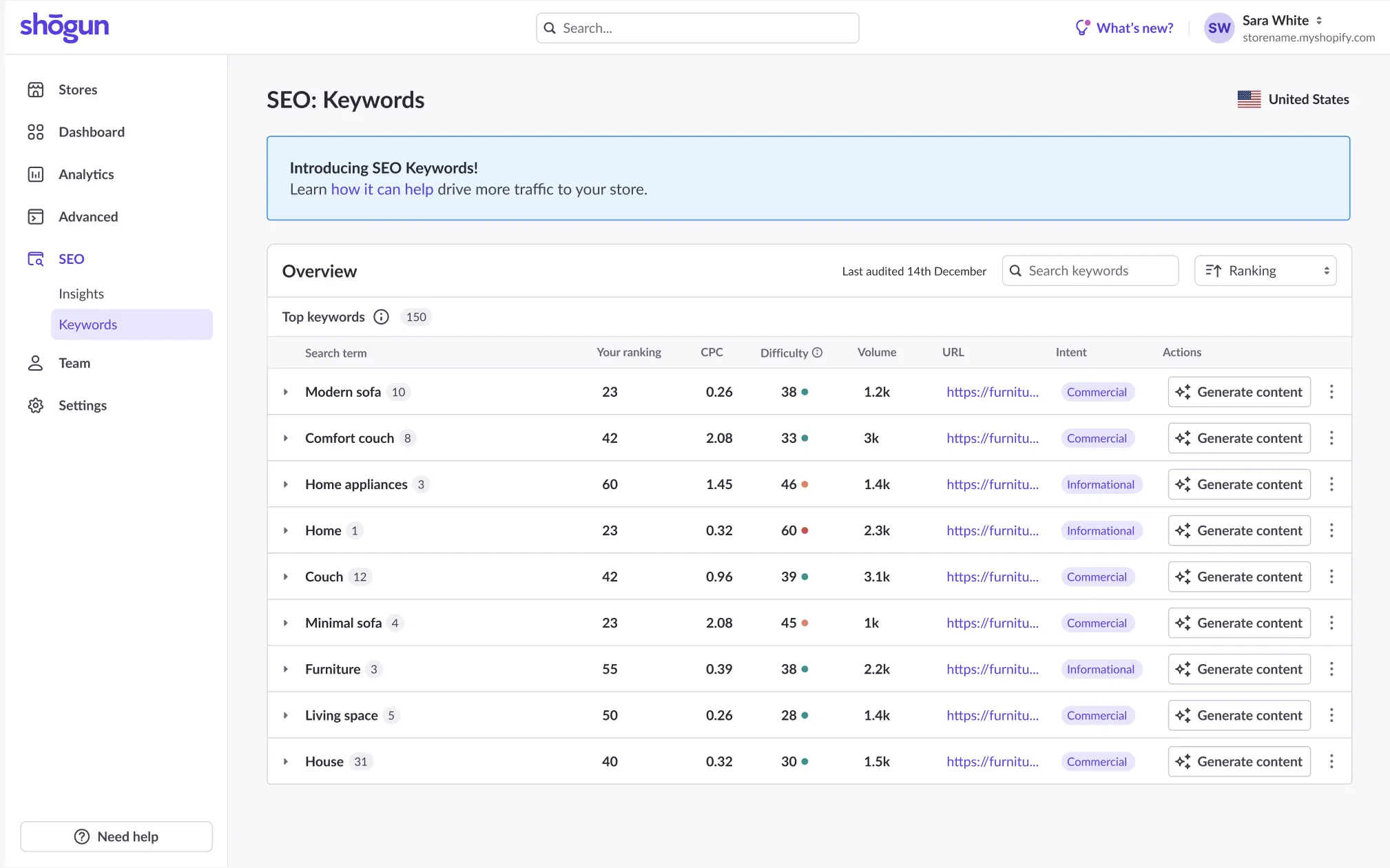Maximizing Your Shopify Product Pages for SEO

There are many ways that people might stumble across one of your Shopify product pages. They might click on one of your paid ads, discover you on social media, follow a referral link from another site, etc.
The most likely way, though, is through organic search — in other words, search results that aren’t paid advertisements. Indeed, organic search drives 53.3% of all web traffic. Making your site more visible on search engine results pages (SERPs), a practice known as search engine optimization (SEO), will help you find many more potential customers.
It should be noted that your Shopify product pages will need to be very visible on SERPs to attract a significant amount of traffic. On the average SERP, the first organic result gets 39.8% of the click-through traffic, and the first four organic results get a combined 76.1% of the traffic. You’ll need to make it near the top of the rankings to really benefit from being listed on a SERP.
The algorithms that Google and similar services use to determine their search rankings are notoriously complex, though. They take hundreds of factors into account, and they’re somewhat vague about what these factors actually are and how they’re weighted as well.
Below, we’ll help clear up this confusion and show you what it takes to improve Shopify product page SEO.
In this post, you will learn:
- The various ranking factors that impact product pages within search engines
- How to optimize your product pages including keyword optimization
- Using Shogun to create content optimized around important keywords
Ranking Factors for Shopify Product Pages in SEO
First of all, search engines need to be able to find your product pages in order for you to get a high ranking (or any ranking at all for that matter).
Search engines use programs called crawlers to scour the internet and add new pages to their index. Due to these crawlers, you often won’t need to do anything to have your published pages indexed by search engines. You can enter “site: [your Shopify store’s URL]” into Google to see which of your pages have already been indexed. More detailed information is available through Google Search Console.

If you notice that any of your product pages haven’t been indexed, try submitting your sitemap to Google.
A sitemap is a file containing all of the URLs that you want to be indexed by search engines. Shopify automatically generates a sitemap with links to your products, primary product images, collections, blog posts, and other pages. Your sitemap can be accessed by adding “/sitemap.xml” to your Shopify store’s URL (e.g., “www.example.com/sitemap.xml”), and then you can submit it by using a Sitemaps report on Google Search Console.

Once you confirm that your Shopify product pages are being indexed, there are four main ranking factors to consider when attempting to improve your rankings:
- Relevance: How closely does your product page match what search engine users are looking for? Google isn’t a charity — they make hundreds of billions of dollars per year by selling ads. They’re able to do this because they have an exceptionally large audience to offer to advertisers, and they’ll only be able to maintain this audience as long as users remain satisfied with their service. If search results don’t match search queries, users aren’t going to be happy. The more relevant your page is to a given search query, the more likely Google is to reward you with a high ranking.
- Quality: When visitors land on your site from a search engine, how long do they stay? Whenever people click on a SERP link only to quickly back out and try another option, Google takes this as a sign that the user wasn’t satisfied with the result. People tend to stay longer on product pages that look good, have well-written descriptions, and are easy to navigate. After all, if a company’s product pages are low-quality, that indicates the products themselves may be as well.
- Links: One way that search engine crawlers discover pages is by following links from known pages to new pages. Adding internal links to your product pages (e.g., from a collection page to a product page or from a product page to a related product page) will help them get indexed. Internal links may also help your rankings on SERPs, as linking one of your more popular pages to a less popular page will often make the less popular page look more authoritative to search engine algorithms.
- Performance: Relevance, quality, and links aren’t going to matter at all if your pages take forever to load. A recent survey found that 53% of online shoppers expect sites to load within three seconds, and 50% will abandon their cart if a site takes too long to load. So, not only will performance issues essentially cut your sales in half — such issues will wreck your time on site and bounce rate stats, lowering your rankings on SERPs and thus costing you potential sales in the future.
Optimizing Your Product Page for Best Results
Now that we’ve covered what Google and other search engines look for, let’s go over what you can do with this information to improve Shopify product page SEO.
Keyword research
Before you can make your product pages more relevant to search queries, you’ll need to know what people are searching for in the first place.
There are many tools available that can show you which keywords (the phrases people enter into search engines to find content) are relevant to your store, how much search volume they get, and how difficult it would be to rank for them. Another important factor to consider is keyword intent. Keywords with informational intent indicate that the searcher wants to learn something, while keywords with commercial intent indicate that the customer is ready to buy something. Informational keywords aren’t a good fit for product pages — you should be targeting commercial keywords instead.
Keyword placement
Once you know which keyword you want to target, the next step is to insert the keyword in the most prominent parts of your product page, such as:
- URL
- Title
- Headings
- Product Description
- Meta Description
- Copy within the page outside of headings and titles
You don’t want to go overboard, though. Repeating the same keyword over and over on a product page won’t help you rank any higher–and it’s terrible from a user experience perspective.
The most important place to get the keyword placement right is the product page URL.
Keyword Placement in Shopify Product Page URLs
By default, Shopify uses the title of your product to create the URL for the page. You’ll want to make sure that each and every one of your product pages has a unique URL that is mapped to a keyword that your customers are actively searching for.
To replace generic product page URLs in Shopify with new ones based on keyword research that you’ve done for that particular product, first select the “Products” option in the left sidebar of the main Shopify dashboard.

Select the product page that you want to edit. In this example, let’s imagine your keyword research has turned up that people are searching for not just organic milk bone dog treats, but certified organic milk bone dog treats.

Scroll down to the “Search engine listing” section and select “Edit”.

From here, you can change the title, meta description, and URL handle of your Shopify product page.

A URL like “yourstore.com/products/certified-organic-milk-bone-dog-treats” is perfect for SEO — it’s descriptive without going too far. Trying to stuff multiple keywords into the same URL (e.g., “yourstore.com/products/certified-organic-milk-bone-dog-treats-treats-for-large-dogs-treats-for-small-dogs” is bad for user experience and often makes the URL less accurate, which can result in a lower ranking.
Keyword Placement in Product Descriptions
Your product description isn’t just a place to shove keywords onto the page. You can use this text to improve user experience by addressing common concerns, explaining all the features of your product, and highlighting exactly how these features will benefit the visitor. This will both keep visitors on your product page longer and improve your odds of making the sale.
Keep in mind that you should write unique descriptions on each of your product pages, even if you have products that are quite similar.
Exact repeats can result in duplicate content penalties.
Product images and video
Providing high-quality product photography will certainly improve the user experience of your product pages. Since customers won’t be able to check out your products in-person, they need to have some sense of what’s going to arrive at their door in order to feel comfortable clicking the buy button.
You may want to add videos of your products as well — this is especially important for when a product demonstration is needed to explain how a product works and why it benefits customers. Producing product photography and videos can sometimes be costly, but they will simultaneously help improve your conversion rate, increase your average time on site, and lower your bounce rate. It’s well worth the investment.
Page speed
As mentioned above, your pages will need to load fast if you want visitors to stick around. Any performance issues that pop up must be fixed as soon as possible.
For example, as important as images are for your product pages, they can really slow down your site if you don’t use them in the right way. Those who want to make their product pages faster should see if they can reduce the size and resolution of product images without significantly diminishing their quality.
How Shogun Helps Brands Optimize Their Product Pages in Shopify
Shogun’s SEO Keywords Analyzer is an excellent tool for keyword research. This feature can show you which keywords are currently driving traffic to your store, and for each keyword you’ll be able to see details such as the search volume, how difficult it is to rank for that keyword, and whether the keyword intent is informational or commercial.
With the help of this report, you’ll know exactly which keywords are worth targeting for your Shopify store.
Focusing on keywords with commercial intent that you don’t yet have a high ranking on can be a great strategy when looking for some easy wins.
You’ll have the best odds of improving your rankings for keywords that have a low difficulty score and relatively low volume (long tail keywords).

For more ideas on how to improve your rankings, check out Shogun’s performance insights feature. These reports give your page an overall score, as well as individual scores for accessibility, best practices, performance, and SEO, on a scale of 0 to 100. Whenever a score is less than 100, Shogun will tell you what the issue is and how to fix it.

As for the quality of your Shopify product pages, this is where Shogun’s visual editor comes in. This tool provides you with a vast library of elements for building ecommerce pages, including images and video for showing off your products, FAQ sections for addressing common concerns, product boxes for internal linking, and much more.
Each element is fully customizable, and you’ll be able to place elements wherever you want them on the page. This tool allows even those who have absolutely no web design experience to create their own high-quality Shopify product pages.
Find keyword opportunities for your Shopify store with ShogunDiscover keyword opportunities and create content with AI to maximize SEO results. Get started now

Phill Moorman
Phill, the VP of Marketing at Shogun, is a seasoned expert in ecommerce. With a keen focus on strategic marketing, Phill drives growth and cultivates brand success in the dynamic online marketplace.



